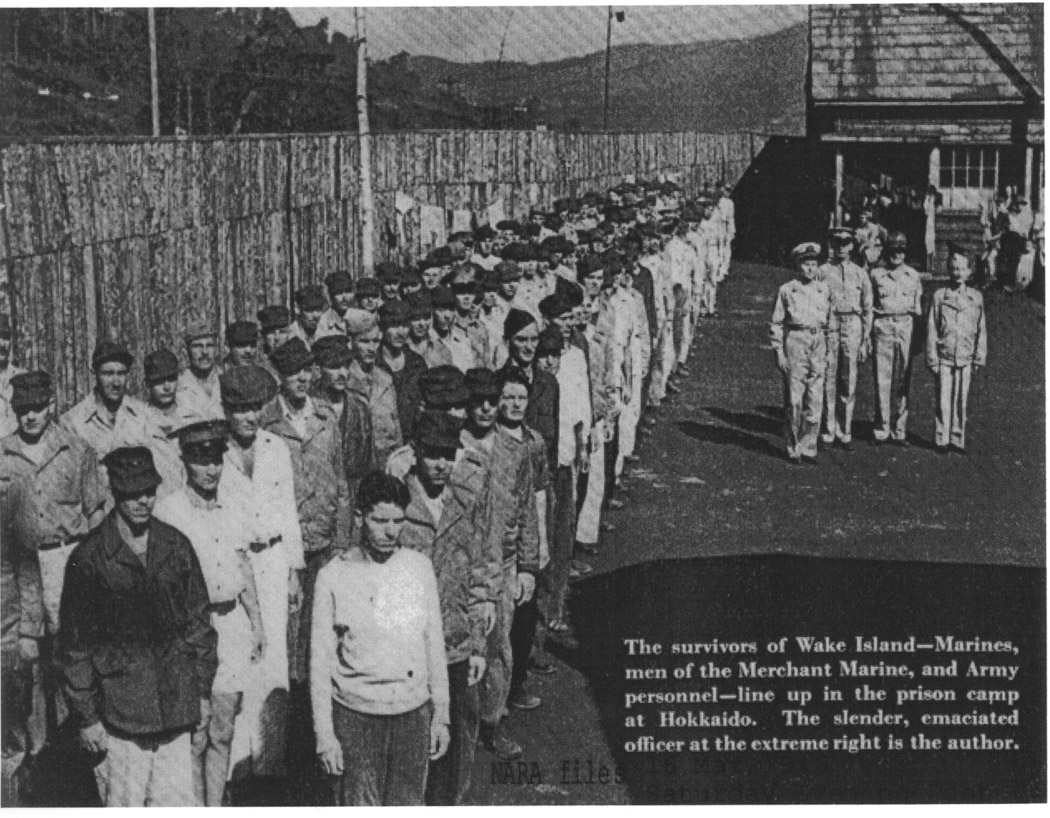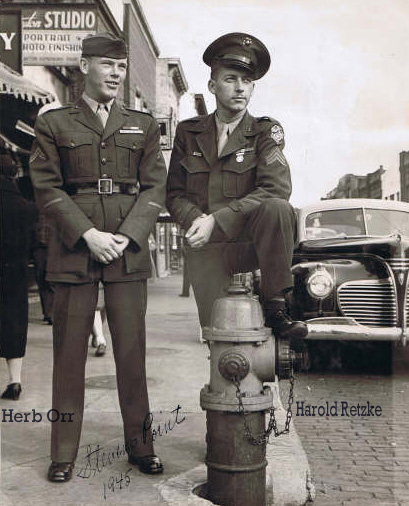Hakodate # 3 - Utashinai

The issue of which North China Marines were in which of the Hakodate camps is slightly unclear. All the officers were held at Camp # 4, Nishi-Ashibetsu. The enlisted men were held at Camp # 2, Akabira or Camp # 3, Utashinai. All three camps were within a few miles of each other. If the rescue rosters are correct they show 100 North China Marines in the three camps at time of rescue (about 15 Sep 45).Some men remember certain individuals being in one of the camps with them but rescue rosters show that individual in the other camp. At least one is in a photo at Akabira but on the rescue roster for Utashinai. Diaries kept by individuals put them in one camp but other notes put them in a different camp. John White's book confuses the issue more. He says Colonel Ashurst sent him to Akabira after the Japanese surrender to take command of that camp. He gives the impression Akabira held the majority of the North China Marine enlisted men. But rescue rosters have only 28 NCM at Akabira and 63 at Utashinai. White's book was written thirty years after the fact - this may explain the differences. White definitely went to Akabira, men who appear in a photo taken just before rescue at Akabira remember him being there.After the Japanese surrender and before rescue men from the two camps would walk to the other to visit. This is probably also a factor in the confusion. Men who spent their time in Akabira may have been at Utashinai when the rescue rosters were made up. There is no way at this time to determine exactly who was were. Nor does it matter. The prisoners from China arrived at all three Hakodate camps just after 4 July 1945. Conditions and work at Akabira and Utashinai were close to identical. All the men were rescued about 15 Sep 1945.___________________________________________________________
Rosters place the following at Utashinai at the end of the war:Andresson, R Armstrong, Bennison, Benson, Benton, Biggs, Bishop, Blahuta, Boyden, Bradshaw, Brawdy, F Brown, Castleton, Chambers, Ciarrachi, Cole, Crafts, Crews, K Davis, Davison, Dietz, Ditewig, Dobson, Eccles, Ellis, Estep, Evans, Foster, Fox, Glaze, Goldman, Griffin, E Hall, Hirschkamp, Kossyta, Leppert, McCarthy, McLeod, McFarland, F Miller, O Miller, Mohr, Nahas, Newhouse, Orr, Permenter, Plog, Pollard, Prater, Rehm, Reilly, Retzke, R Smith, Sousek, Sparman, J Stewart, Stone, Stowers, Sydow, Timpany , Walmer, Williams, and Wolf.
Click here to view map of all Hakodate/Hokkaido camps.
Click here to view the entire roster for Utashinai.
UTASHINAI, Page 1 of 2
PRISONER OF WAR CAMPS IN JAPAN and JAPANESE CONTROLLED AREAS
AS TAKEN FROM REPORTS OF INTERNED AMERICAN PRISONERS
LIAISON and RESEARCH BRANCH AMERICAN PRISONER OF WAR INFORMATION BUREAU
byJOHNM,GIBBS31 July 1946
UTASHINAI,
A DIVISIONAL CAMP OF HAKODATE NO 3 ON THE NORTHERNMOST ISLAND OF JAPAN. HOKKAIDO
1. LOCATION: On the environs of the mining town of Utashinai. on the Island of Hokkaido, about 12 miles east of Takikawa and approximately 15 miles west of Ashibetsu Utashinai lies about 35 miles inland from the Sea of Japan on the West. The coordinates are 43°31'N.,142°03'E. The size of the compound was approximately 90' across at its greatest width and 240'long. The installation laid in a narrow valley, less than 600' in width. Directly to the west and southwest of the compound were to be found densely grouped miners quarters (quite old) inhabited by Korean mine-workers, and
approximately 225' to the west was a power substation,
The population of the mining town was approximately 2.500, of which number about 1.000 were Korean conscripted laborers. The chief activity of the town was mining. In fact. all facilities in this area were controlled or owned by the Hokkaido Shipping and Mining Company, the local branch of which was Sorachi Mining Co., to which the prisoners were released for work in the mines. The Shipping and Mining Co. owned the telephone and telegraph lines and the railroads.
There were no public telephone or telegraph facilities.
2. PRISONER PERSONNEL' This camp was first utilized as an internment installation for prisoners of war and the occupants arrived 7 July 1945 comprised of 285 Americans and a detail of approximately 45 British largely from Hong Kong, The American personnel may with reasonable correctness be broken down as follows: Army 5, Navy 15; Marines 212 (from Wake and North China) and 53 Merchant Marines = 285. The total prisoner personnel on the opening day of the camp was 330 and it remained at that figure until the camp was liberated.
Lt (sg) EG.P.Pollard, USN Dental Corps was Sr. Officer Lt (jg) G.M. Kahn. USN-MC. was Jr Officer, These officers were assisted by Marine Gunner C,B, McKinstry, USMC, and Marine Gunner John Hamas, USMC.
Maj, (now Lt. Col) James P.S. Devereux was sent to this camp to rejoin his old Wake Island detail after the Japanese surrendered.
3. GUARD PERSONNEL: Camp commandant Kinsaburo Niizuma. Capt. in Nip Army, weak and indifferent, Adm, Assl. Kozo Ishigooka, Sgt, Maj. Nip Army, condoned the malpractices of his subordinates, Paymaster and Q.M. Seizaburo Isa, Sgt. Nip Army. Medical Corpsman Unesaku Nakao, Cpl. Nip Army, and Hisao Kawasaki, private Nip Army.
4. GENERAL CONDITIONS:
(a) HOUSING FACILITIES: The barracks formerly housed the Korean mine laborers. They were poorly heated and were infested with bed bugs. lice and fleas. The barracks, a single building of two stories, was made of wood, with roof and floors of same material. The structure was divided into 8 sleeping sections and in each section were two galleries, reached by ladders, which accommodated 10 men each. Another 20 men slept on the ground floor, termed the main deck.
The dimensions of the sections were 15'x23' on the ground floor and 8'x15' in the two galleries. The building was badly crowded. The interior contained no furnishings of any kind and food had lo be served on the floor,
(b) LATRINES: Very poor .facilities. The latrine, adjacent to sleeping quarters, contained 10 openings in the floor, squat type, with cement vat underneath. The prisoners were compelled to empty the vat with buckets which then was used as a fertilizer. The latnne also contained two open urinal troughs. No deodorants were furnished, consequently the prisoners suffered from the continual stench from the latrine.
(c) BATHING: The bath was located in a shed in the rear of the barracks. One large wooden tank 12*x15' constituted the equipment. Hot water was not available. The single tub was used by all the prisoners,
(d) MESS HALL: This is where the food was prepared by prisoner cooks. The food was carried into the barracks in buckets and there eaten,
(e) FOOD: The prisoners were issued one small tea-cup of cooked rice three times per day, approximately 500 grams per day. with a watery stew made from a weed-like stalk called "Fuki". Its cellulose content was high and its food value negligible, in addition, small amounts of dried fish in varying stages of decomposition, were furnished occasionally
According to the Med. Officer this diet was wholly lacking In vital food elements, no protein or fat. and was about 2,000 calories per day deficient to maintain minimum health. No tea or other drink, except hot water, was furnished,
(f) MEDICAL FACILITIES: There was no hospital at this camp. The only medical supplies on hand were those which the prisoners brought with them from China. The medical and dental officers, both Americans, were ingenious professionals, who were instrumental in maintaining a reasonably healthful condition in the face of trying and discouraging handicaps.
(g) SUPPLIES: (1) Red Cross-YMCA-Other Relief: None, (2) Japanese Issue: None,
UTASHINAI,Page2of2
(h) MAIL: (1) Incoming: None. (2) Outgoing. Allowed to send one post card of 25 words on reaching camp. Nothing thereafter.
(i) WORK: The working conditions were very poor. There was danger to the prisoners all the time they were underground. The mine shaft was sakj to have been 42 years old. and was in terrible structural condition. Many of the ceiling timbers and props were rotted and broken. Cave-ins on a small scale frequently occurred No deaths resulted in
the mines as a result of structural weakness, but many men received minor injuries severe enough to cause hospitalization in some instances The prisoners were required to walk up and down the shaft incline which approached a 45" angle in slope and 600 yards in depth The wet condition all through the mine was responsible for much bronchial
trouble because the prisoners worked wrth wet feet from the time they entered the shaft until the close of the work hours.
A predominant danger came from overhead electric power wires, which were suspended so low that the tall Americans had to exercise special care to avoid electrocution. Mine work hours were: Day shift 6:30 a.m. to 6:30 p.m.; Night shift 6:30 p.m. to 3:00 a.m.
0) TREATMENT: The prisoners all felt the strain of the hard work in the mines, which was made worse by inadequate food and the compulsion to sleep on the barracks floors with only one blanket.
There was considerable nagging. Beatings were frequently administered by the guards for imagined or petty offenses. Failure to bow and salute when passing within 30 yards of a sentry was the cause of the most of the beatings.
(k)PAY' (l)Officers: 50 yen per month. (2) Enlisted Men: 10 sen per day.
(1) RECREATION: None,
(m) RELIGIOUS ACTIVITIES: None.
(n) MORALE: Good at first but dropped fast under oppressive mine working conditions.
5. MOVEMENT: By train (day coaches) to airport at Chitose, approximately 80 miles south of the camp. At Chitose the prisoners were met by an American Army Aviation group. This camp was liberated on 15 Sept. 1945.
I talked with Esther Orr in October of 2003. She explained how she met Herb Orr while on a date with someone else in Stevens Point, Wisconsin. It was 5 November 1945. Her date recognized Herb walking by and invited him to sit with them. When the date went to the bathroom Herb got her phone number. They were married 5 March 1946. Esther had seen the picture below of Herb Orr and Harold Retzke in the Stevens Point paper. Both Herb and Harold were from Stevens Point. Herb graduated from PJ Jacobs High School in Stevens Point in 1936. He enlisted in the Marine Corps on 5 Jan 1940 and went to boot camp in San Diego. He retired on 28 Feb 1970 after thirty years service. Herb was assigned to Japan after the war. While riding a train he spotted a former guard, and the guard spotted him. About that time the train went through a tunnel. When they came out of the tunnel the guard had disappeared.

Click below to return to: |